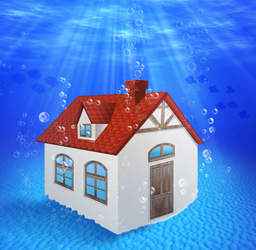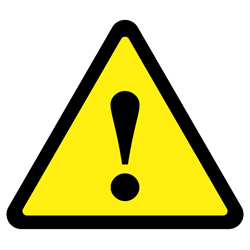Beware Of These Top Three Flooding Health Hazards!
Our previous articles outlined the top three facts about water damage restoration and three steps to reduce flood damage. The purpose of this article is explain the top 3 health hazards created by water damage.
The primary goal of water damage restoration is to help you get back to your normal routine by restoring your property to its pre-flood condition.
The secondary goal of restoration professionals it to minimize these three water damage health hazards:
1. Mold Growth
2. Bacteria Growth
3. Structural Damage
Hazard #1: Mold Growth
Where there is moisture, there will be mold. Unfortunately, if you experience water damage from a flood, the issue of mold is a bigger concern because there is so much moisture to promote mold growth. Mold is a problem because it can cause illness and this is the primary reason you want to prevent mold from growing.
Research done by Dr. Harriet Ammann, a mycotoxin expert, shows that mold exposure can damage the bodies systems:
- Vascular: blood vessel fragility, hemorrhage from tissues or lungs
- Digestive: diarrhea, vomiting, hemorrhage, liver damage, fibrosis and necrosis
- Respiratory: trouble breathing, bleeding from lungs
- Neurological: tremors, loss of coordination, headaches, depression, multiple sclerosis
- Skin: rashes, burning, sloughing, photosensitivity
- Urinary: kidney toxicity
- Reproductive: infertility, changes in reproductive cycles
- Immune: Immunosuppression
Interviews with mold survivors shows that chronic mold exposure can lead to mycotoxicosis. The negative impact of mold on the health is growing and has been well documented most recently in articles written by the CEO of Wonder Makers Environmental, Michael Pinto in three key articles:
1. Medical Evidence that Connects Mold Exposure to Illness Keeps Piling Up
2. The Answer to the Mold Illness Questions Is: All of the Above
3. Do People Really Get Sick From a Little Mold in Their House?
One of the keys to preventing mold growth is to ensure that the water damaged area is completely dry before any reconstruction occurs. Unfortunately, this does not occur all the time, particularly when you hire inexperienced restoration contractors. To avoid this from happening, be sure that you pre-qualify your contractor and do your due diligence, review this article to learn more about the pre-qualifying process.
Hazard #2: Bacteria Growth
As explained in a previous article, one of the main priorities of a restoration contractor is to determine the category hazard of the water, ie. is it category 1, 2, or 3. This is very important because the worse type of water is black water which can cause some serious health conditions: gastroenteritis; Weil’s disease also known as Leptospirosis; Hepatitis; acute respiratory illnesses; and tetanus.
The number one rule about water damage is the longer you wait, the worse it will get. This is particularly true when you are trying to prevent hazardous bacteria from growing because category 1 water can turn into category 2 water and eventually category 3 water, which is the most toxic and causes many illnesses.
Hazard #3: Structural Damage
Water damage can impact the structural integrity of a property because large amounts of water can degrade the strength of the materials.
This is particularly true when mold begins to grow because mold feeds on the material and will continue to feed until it has finished consuming the material. This is the reason wood will rot when mold contaminates it.
As the wood is consumed and begins to rot, this will negatively impact the structural integrity of the home creating a health hazard, not to mention rotting wood will reduce the value of the property as well.
How Do I Protect My Family and Property If My Home Is Flooded?
Hiring an experienced professional is the most important step to protecting the health and well-being of your family. Experienced restoration professionals, like Mold B Gone, will not advise you to rush into the reconstruction phase of your restoration project because they understand that the key to preventing mold is to ensure that the flood affected area is completely dry.
Reconstruction after restoration is essential to restoring the daily routine of your life. However, if the property is reconstructed and moisture is still present, this will create long term headaches and costs because mold will grow. To avoid mold growth, patience is the key to allow the area to dry completely.
You will know that reconstruction has occurred to soon if you begin to have condensation on your windows; smell musty odors; and find other clues that moisture is present including water stains, new or increased allergy symptoms, cracked or peeling paint, loose drywall tape or wall paper, rusty metal, and drawers or doors that stick.
If you do have a mold problem, then please avoid fly-by-night mold removal contractors that lack experience and credentials. They may present you with cheaper mold removal estimates, particularly if they tell you they can remediate your mold with ozone, do all the clean up with bleach, or simply run a machine that fogs and kills the mold.
To avoid the pitfalls of hiring fly-by-night operators who do not offer a guarantee and lack experience, hire a professional like Mold B Gone that has years of experience, specialized training, equipment, and a solid reputation in the community. Experienced contractors will provide you with a recovery plan of action that outlines what will be done to address the water damage and prevent mold growth. The plan will outline the following for you:
- An assessment of the category of water and extent of damage;
- A scope of work that will assess structural issues based on the class of damage;
- Content removal and cleaning plan;
- Steps required to remove excess water;
- A drying and monitoring strategy using air movers and dehumidifers; and
- A sanitizing plan to ensure a healthy environment.
Furthermore, we do not recommend that you begin the cleanup or tear up yourself, particularly because of the potential hazards that asbestos may cause if asbestos containing materials become air borne. However, if you have contacted a professional and are waiting for them to arrive and must begin some of the clean up yourself, take the following precautions:
- Have the area cleared by emergency workers if you have standing water in an area where fuse boxes and/or electrical circuitry is submerged before attempting to pump out the water.
- Turn off your gas line.
- Wear an N95 or N100 respirator mask, available at most hardware and medical supply stores.
- Wear rubber boots and puncture-resistant gloves. Ideally, don a polypropylene coverall.
- Be sure to carefully dry any belongings you want to try to save.
- Items that should be thrown out, particularly if they have been underwater include the following: carpet, carpet padding, and rugs; upholstered furniture; computers, microwaves, window A/C units, or any appliances that have fans; papers and books; and food items, including canned foods if they were in contact with flood waters.
The primary purpose of water damage restoration is to restore the property to pre-loss condition. Before the reconstruction phase of the project begins, we recommend that you consult with an environmental consultant to do post remediation tests, particularly if there was any mold, category 2 or 3 water present. This is an important step before reconstruction because it will verify that the water damage restoration was done properly.
If you have questions, call us, 678-697-6267 or use our online form. We look forward to serving you!
Flood and water damage not only disrupts your life but can also be hazardous to your health! This article explains the top 3 hazards and prevention measures!
Posted by Mold-B-Gone Remediation, LLC on Friday, September 11, 2015
The Top 3 Water Damage Hazards! | (Plus prevention measures) #mold PLS RT http://t.co/Br56h2Ah7V pic.twitter.com/QoCUhpVquo
— Mold B Gone (@moldbgonega) September 12, 2015


